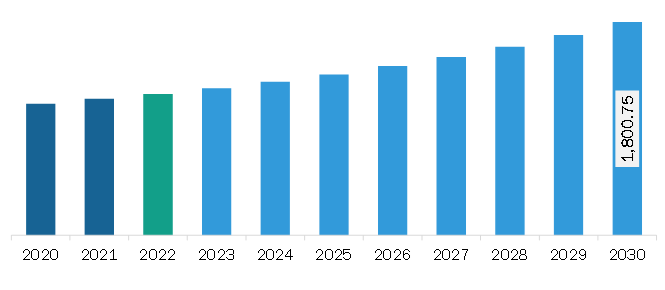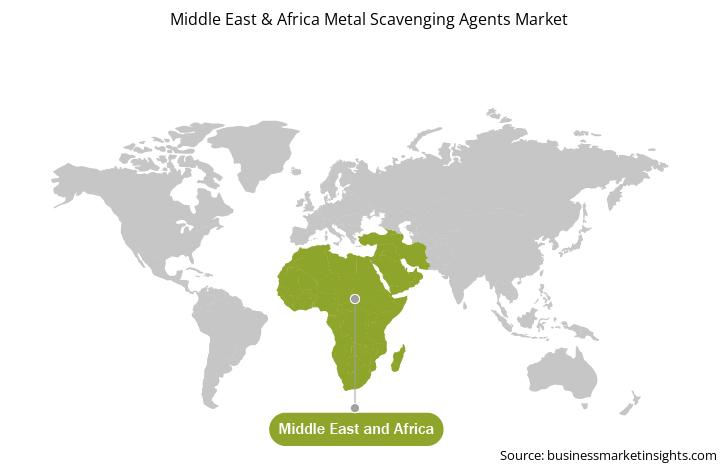Middle East & Africa metal scavenging agents market was valued at US$ 1,192.97 million in 2022 and is expected to reach US$ 1,800.75 million by 2030; it is estimated to register a CAGR of 5.3% from 2022 to 2030.
Ongoing research and development efforts in the field of metal scavenging technologies are driving the emergence of advanced solutions poised to revolutionize metal removal processes. Innovations such as nanomaterial-based adsorbents, functionalized membranes, and hybrid sorbent systems can represent promising avenues for achieving higher efficiency, selectivity, and sustainability in metal scavenging applications. Nanomaterial-based adsorbents leverage the unique properties of nanomaterials such as high surface area, tunable surface chemistry, and enhanced reactivity to efficiently capture and remove heavy metal ions from aqueous solutions. Nanostructured materials such as nanoparticles, nanotubes, and nanofibers offer superior adsorption capacities and kinetics compared to conventional adsorbents, enabling more effective metal removal and wastewater treatment.
Functionalized membranes incorporate surface or coating modifications to impart specific metal-binding functionalities, enhancing their affinity and selectivity toward target metal ions. By integrating metal-chelating ligands or functional groups onto membrane surfaces, functionalized membranes can selectively capture and concentrate metal contaminants while allowing for efficient water permeation, enabling the development of membrane-based metal scavenging systems with improved performance and reliability.
Hybrid sorbent systems combine multiple metal scavenging mechanisms such as adsorption, ion exchange, and precipitation into integrated platforms to synergistically enhance metal removal efficiency and capacity. By leveraging the complementary advantages of different sorbent materials and mechanisms, hybrid systems can overcome the limitations of individual techniques and achieve superior metal removal performance under diverse operating conditions, offering enhanced versatility and flexibility in metal scavenging applications. The advanced metal scavenging technologies hold significant promise for addressing challenges associated with heavy metal pollution in various industrial and environmental contexts. By offering higher performance, cost-effectiveness, and sustainability compared to traditional metal removal methods, these innovations are poised to revolutionize metal scavenging processes and contribute to the development of more efficient and environmentally friendly solutions for metal pollution control and remediation Thus, the growing technological advancements and research and development on metal scavenging agents such as nanomaterial based metal scavenging agents, functionalized membranes, and hybrid sorbent system, would further drive the market in future.
The Rest of Middle East & Africa comprises countries such as Egypt, Nigeria, Oman, Qatar, Kuwait, Iran, Turkey, and Kenya. The demand for metal scavenging agents in the Rest of Middle East & Africa is driven by the increasing use of metal scavenging agents in the region's pharmaceutical, chemical, and oil & gas sectors. Countries such as Qatar are the largest global liquefied natural gas (LNG) exporter. According to the International Trade Organization, Qatar's crude oil production was at ~ 1,300,000 barrels per day, making Qatar one of the top 15 oil exporting countries. Thus, dominating oil & gas-producing countries is expected to boost the metal scavenging agents market growth in the Rest of the Middle East & Africa.

Strategic insights for the Middle East & Africa Metal Scavenging Agents provides data-driven analysis of the industry landscape, including current trends, key players, and regional nuances. These insights offer actionable recommendations, enabling readers to differentiate themselves from competitors by identifying untapped segments or developing unique value propositions. Leveraging data analytics, these insights help industry players anticipate the market shifts, whether investors, manufacturers, or other stakeholders. A future-oriented perspective is essential, helping stakeholders anticipate market shifts and position themselves for long-term success in this dynamic region. Ultimately, effective strategic insights empower readers to make informed decisions that drive profitability and achieve their business objectives within the market.

| Report Attribute | Details |
|---|---|
| Market size in 2022 | US$ 1,192.97 Million |
| Market Size by 2030 | US$ 1,800.75 Million |
| CAGR (2022 - 2030) | 5.3% |
| Historical Data | 2019-2020 |
| Forecast period | 2022-2030 |
| Segments Covered |
By Type
|
| Regions and Countries Covered | Middle East and Africa
|
| Market leaders and key company profiles |
|
The geographic scope of the Middle East & Africa Metal Scavenging Agents refers to the specific areas in which a business operates and competes. Understanding local distinctions, such as diverse consumer preferences (e.g., demand for specific plug types or battery backup durations), varying economic conditions, and regulatory environments, is crucial for tailoring strategies to specific markets. Businesses can expand their reach by identifying underserved areas or adapting their offerings to meet local demands. A clear market focus allows for more effective resource allocation, targeted marketing campaigns, and better positioning against local competitors, ultimately driving growth in those targeted areas.

The Middle East & Africa metal scavenging agents market is categorized into type, end-use industry, and country.
By type, the Middle East & Africa metal scavenging agents market is segmented into alumina-based, carbon-based, silica-based, resin-based, and others. The others segment held the largest share of the Middle East & Africa metal scavenging agents market share in 2022.
In terms of end-use industry, the Middle East & Africa metal scavenging agents market is segmented into water treatment, food & beverages, pharmaceutical, oil & gas, chemicals, paper & pulp, and others. The paper & pulp segment held the largest share of the Middle East & Africa metal scavenging agents market share in 2022.
Based on country, the Middle East & Africa metal scavenging agents market is segmented into South Africa, Saudi Arabia, the UAE, and the Rest of Middle East & Africa. The Rest of Middle East & Africa segment held the largest share of Middle East & Africa metal scavenging agents market in 2022.
BASF SE, Biosynth AG, Biotage AB, Johnson Matthey Plc, Merck KGaA, SiliCycle Inc, and Supra Sciences Pvt Ltd are some of the leading companies operating in the Middle East & Africa metal scavenging agents market.
The Middle East & Africa Metal Scavenging Agents Market is valued at US$ 1,192.97 Million in 2022, it is projected to reach US$ 1,800.75 Million by 2030.
As per our report Middle East & Africa Metal Scavenging Agents Market, the market size is valued at US$ 1,192.97 Million in 2022, projecting it to reach US$ 1,800.75 Million by 2030. This translates to a CAGR of approximately 5.3% during the forecast period.
The Middle East & Africa Metal Scavenging Agents Market report typically cover these key segments-
The historic period, base year, and forecast period can vary slightly depending on the specific market research report. However, for the Middle East & Africa Metal Scavenging Agents Market report:
The Middle East & Africa Metal Scavenging Agents Market is populated by several key players, each contributing to its growth and innovation. Some of the major players include:
The Middle East & Africa Metal Scavenging Agents Market report is valuable for diverse stakeholders, including:
Essentially, anyone involved in or considering involvement in the Middle East & Africa Metal Scavenging Agents Market value chain can benefit from the information contained in a comprehensive market report.